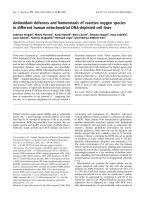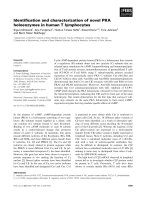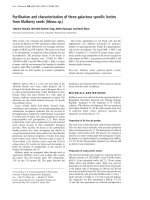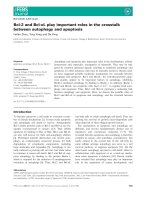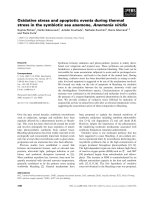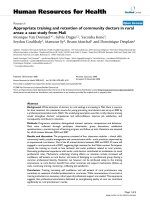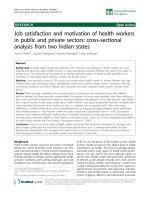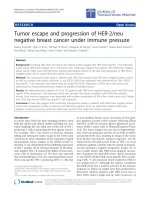Báo cáo sinh học: " Expression pattern and polymorphism of three microsatellite markers in the porcine CA3 gene" pptx
Bạn đang xem bản rút gọn của tài liệu. Xem và tải ngay bản đầy đủ của tài liệu tại đây (121.52 KB, 13 trang )
Genet. Sel. Evol. 40 (2008) 227–239 Available online at:
c
INRA, EDP Sciences, 2008 www.gse-journal.org
DOI: 10.1051/gse:2007046
Original article
Expression pattern and polymorphism
of three microsatellite markers
in the porcine CA3 gene
Jian Wu
1∗∗
, Donghai Zhou
2∗∗
, Changyan Deng
3∗
, Yuanzhu
X
iong
3
, Minggang Lei
3
, Fenge Li
3
,SiwenJiang
3
,BoZuo
3
, Rong
Z
heng
3
1
Department of Basic Veterinary Medicine, College of Veterinary Medicine,
Huazhong Agriculture University, Wuhan, 430070, P. R. China
2
Department of Clinical Veterinary Medicine, College of Veterinary Medicine,
Huazhong Agriculture University, Wuhan, 430070, P. R. China
3
Key Laboratory of Agricultural Animal Genetics, Breeding and Reproduction of Ministry
of Education and Key Laboratory of Swine Genetics and Breeding of Ministry of Agriculture,
Huazhong Agriculture University, Wuhan, 430070, P. R. China
(Received 12 February 2007; accepted 21 August 2007)
Abstract – Carbonic anhydrase III (CA3) is an abundant muscle protein characteristic of adult
type-1, slow-twitch, muscle fibres. In order to further understand the functions of the porcine
CA3 protein in muscle, the temporal and spatial distributions of its gene product were analysed
and the association between the presence of specific polymorphisms and carcass traits in the
pig was also examined. Real-time PCR revealed that the CA3 mRNA expression showed no
differences with age in skeletal muscles from Yorkshire pigs at postnatal day-1, month-2, and
month-4. We provide the first evidence that CA3 is differentially expressed in the skeletal muscle
of Yorkshire and Meishan pig breeds. In addition, the whole pig genomic DNA sequence of CA3
was investigated and shown to contain seven exons and six introns. Comparative sequencing of
the gene from three pig breeds revealed the existence of microsatellite SJ160 in intron 5 and
microsatellite SJ158 and a novel microsatellite marker that includes a tandem repeat of (TC)
n
in intron 4. We also determined the allele number and frequencies of the three loci in seven
pig breeds and found that they are low polymorphic microsatellite markers. Statistical analysis
showed that the CA3 microsatellite polymorphism was associated with dressing percentage,
internal fat rate, carcass length, rib number and backfat thickness in the pig.
pig / carbonic anhydrase III / expression pattern / microsatellite polymorphism
∗
Corresponding author:
∗∗
These two authors contributed equally to this work.
Article published by EDP Sciences and available at
or />228 J. Wu et al.
1. INTRODUCTION
Carbonic anhydrase III (CA3) is a member of a gene family encoding pro-
teins, which catalyse the hydration of CO
2
to generate protons and bicarbonate
ions for cellular ion transport and pH homeostasis. It is an abundant muscle
protein characteristic of adult type-1, slow-twitch, muscle fibres. The protein
plays an important role in facilitated CO
2
diffusion and diverse processes in-
volving H
+
and HCO
−
3
transport [2]. Pig muscle carbonic anhydrase III is
a 30 kDa protein displaying three activities i.e. CO
2
hydratase, acetate es-
terase and p-nitrophenyl phosphatase [10]. The CA3 gene was first isolated
in man [8]. Studies have shown that the expression of the CA3 gene is strictly
tissue-specific and is high in skeletal muscle and much lower in cardiac and
smooth muscles [9]. The porcine CA3 gene has been assigned to pig chromo-
some SSC4q11-q12 [4]. Previously, we have reported the cDNA sequence of
the porcine CA3 gene and polymorphic sites within this gene. Liu et al. [7]
isolated the porcine CA3 gene by mRNA differential display in the longis-
simus dorsi muscle tissues from a Landrace × Large White cross-combination.
Wang et al. [11] analysed temporal and spatial expression differences of the
CA3 gene in the pig and reported that the CA3 protein is associated with intra-
muscular fat content and ham percentage.
In this study, we studied the allele frequencies of three microsatellite loci
in the CA3 gene in seven pig breeds. We report the allele frequencies and the
results of association analyses of the three microsatellite markers within the
CA3 gene. Additionally, the expression patterns of the porcine CA3 gene dur-
ing the porcine skeletal muscle development and in different pig breeds were
analysed.
2. MATERIALS AND METHODS
2.1. Analysis of CA3 expression levels
Total RNA was extracted using TRIzoL reagent (Invitrogen, Carlsbad, CA,
USA) from the longissimus dorsi of Yorkshire pigs at postnatal day-1, month-
2, and month-4 and Meishan pigs at postnatal month-2, respectively. Three
animals were sampled for each breed and at each stage. Reverse transcriptase
PCR was carried out using M-MLV Reverse Transcriptase (Promega, USA).
Amplification primer CA (Tab. I) was designed to analyse CA3 expres-
sion levels using porcine CA3 cDNA sequences (AY789514) as templates
and Primer Express software. Quantitative PCR reactions were performed in
25 µL volumes containing 12.5 µL 2 SYBR Green Real-time PCR Master Mix
Microsatellite polymorphisms of CA3 in the pig 229
Tabl e I. Primers used in this study.
Primer
Sequence (5
to 3
)
Binding Annealing Size (bp)
name region temperature (
◦
C)
CA F: GCCAAGGGAGACAACCAA Exon 2 60 234
R: TGAGGAGCCCCAGTGAAG Exon 3
GAPDH-1 F: GAAGGTCGGAGTGAACGGAT Exon 2 60 251
R: CTCATTTGATGTTGGCGGG Exon 4
CA-1 F: GTCCAGTGCCCACGAAGA Exon 1 58 918
R: GGCAGAGCCAGGGTCATA Exon 2
CA2 F: CCTGAACAATGGGAAGAC Exon 2 53 2502
R: GAAGATGAAACTGGCGAA Exon 3
CA-3 F: CACGGATCTGAGCACACT Exon 3 52 1855
R: ATGCCAACTACAGCCACT Exon 4
CA-4 F: CCCTGATGGAGTGGCTGTA Exon 4 57 1386
R: TGGAACTCGCCTTTCTCAC Exon 5
CA-5 F: ATAGGACGTGAGAAAGGCG Exon 5 57 1648
R: GTTGAAGTTCGTGAAGGGT Exon 6
CA-6 F: CTGCGAGGAGTGCATTGTG Exon 6 57 1130
R: CTGCCCTTGATAGGCTGTG Exon 7
SJ16 F: TGAAGTATTTGAGACAGAAGTTGAGG Intron 5 55 179/205
R: TGAGCTACGACTGGAACTCCTAC Intron 5
SJ15 F: TCAAGATATTTCTGCTAAGACAAG Intron 4 55 223/229/231
R: CCTCGTGGATCAACTCTACTTC Intron 4
TC F: TTGGTTTTCTTTTCCCTCTT Intron 4 56 100/102/110
R: GCCTTTCTCACGTCCTATCT Exon 5
(TOYOBO, Japan), 1 µL cDNA and 0.3 µM of a terminal concentration of each
primer. PCR was run on the Applied Biosystems 7500 Real-Time PCR System.
Fluorescent signals were continually monitored at the end of each PCR cycle
comprising 1 min at 95
◦
C for the initial denaturing step, 15 s at 95
◦
C, 15
sat60
◦
C and 50 s at 72
◦
C for a total of 40 cycles. The relative expression
levels of the gene were analysed using the Comparative Ct method, in which
glyceraldehyde-3-phosphate dehydrogenase (GAPDH) was used as an inter-
nal control, to correct for the differences in the mRNA quantities. A specific
primer pair (GAPDH-1, see Tab. I) that amplified a 251 bp fragment was de-
signed and the PCR conditions were identical to those described above. A t-test
was performed to conclude on the significance of the differences observed.
2.2. Genomic DNA amplification and sequence analysis
The cDNA sequence of the pig CA3 gene was compared with the hu-
man and mouse orthologous mRNA and their genomic sequence in order to
230 J. Wu et al.
predict the genomic organisation of the pig gene, which was confirmed by
PCR amplification and sequencing. Six primer pairs were designed to amplify
the genomic sequence including all introns (Tab. I). Three genomic DNA mix-
ture pools from three pig breeds (six Yorkshire pigs, six landrace pigs and
six Meishan pigs) were used. PCR was performed in a 25 µL reaction mix con-
taining the following: 200 ng of genomic DNA pool, 200 µMdNTP,0.4µmol
of each PCR primer, and 1U Taq DNA polymerase in the reaction buffer sup-
plied by the manufacturer. PCR was run as follows: 94
◦
Cfor4min,35cycles
of 94
◦
C for 50 s, optimal temperature (Tab. I) for 50 s, 72
◦
C for 1 min 30 s
and a final extension step at 72
◦
C for 10 min. The purified PCR products were
cloned into the pGEM-T vector (TaKaRa, Dalian, China) and were sequenced
using standard M13 primers. DNA sequences were compiled using the DNA
star software (Madison, WI, USA). The sequencing results of different pig
breeds were compared using BLAST ().
2.3. Detection of microsatellite polymorphisms
Based on the BLAST results of the whole genomic sequence of the pig
CA3 gene in Yorkshire, Landrace and Meishan breeds, microsatellite SJ160
was identified in intron 5, and microsatellite SJ158 and a novel microsatel-
lite marker that includes a tandem repeat of (TC)
n
were identified in intron 4.
Primers SJ16 and SJ15, designed from the primer sequences of pig SJ160
(AB091132) and SJ158 (AB091130), were used to detect microsatellite SJ160
and SJ158 polymorphisms, respectively. Primer TC was designed from porcine
CA3 DNA sequences and used to detect the polymorphism of the novel mi-
crosatellite (TC)
n
(Tab. I). PCR was performed in a 20 µL reaction mix con-
taining the following: 25 ng of genomic DNA pool, 150 µM dNTP, 0.25 µmol
of each PCR primer and 1 U Taq DNA polymerase in the reaction buffer sup-
plied by the manufacturer. PCR was run as follows: 94
◦
Cfor4min,30cycles
of 94
◦
C for 30 s, 55
◦
C for 30 s, 72
◦
C for 30 s and a final extension step at
72
◦
C for 10 min. The denatured PCR products were analysed on 12% poly-
acrylamide denaturing sequencing gels, which were stained in a AgNO
3
solu-
tion and then scanned by the Gel Imaging System (Olympia). To ensure the
accuracy of the alleles analysed in our study, different samples of DNA alleles
were cloned and sequenced.
2.4. Statistical analysis
Allele frequencies were studied in seven different pig populations. The mi-
crosatellite markers were genotyped in 330 F2 pigs of a Yorkshire × Meishan
Microsatellite polymorphisms of CA3 in the pig 231
0
0.5
1
1.5
2
2.5
3
1 day
2 months
4 months
Figure 1. Temporal expression profiles of the porcine CA3 gene. Relative levels of
CA3 mRNA were calculated using the Comparative Ct method with GAPDH as the
reference gene in each sample. Bars represent the mean ± SE (n = 3). Postnatal day-1,
month-2 and month-4 indicate three stages of skeletal muscle development in York-
shire pigs. The differences in the levels of expression were not significant (P > 0.05)
by t-test analysis.
reference family. The association studies between genotype and carcass traits
were performed with the least squares method (GLM procedure, SAS
r
ver-
sion 8.0). The model used to analyse the data was assumed to be:
Y
ijk
= µ + G
i
+ S
j
+ F
k
+ b
ijk
X
ijk
+ e
ijk
where, Y
ijk
is the observation of the trait; µ is the least squares mean; G
i
is
the effect of the ith genotype; S
j
is the effect of the j
th
sex (j = 1 for male or
2 for female); F
k
is the effect of year; b
ijk
is the regression coefficient of the
slaughter weight and e
ijk
is the random residual.
3. RESULTS
3.1. Expression pattern of porcine CA3 gene
During the three stages of skeletal muscle development in Yorkshire pigs,
we observed no statistically significant differences in CA3 mRNA expression
(Fig. 1) as shown by t-test analysis (P > 0.05). An expression pattern was
also performed on the skeletal muscle of both Western Yorkshire and Chinese
Meishan pigs at month-2. The porcine CA3 gene was differentially expressed
in the skeletal muscle of Yorkshire and Meishan breeds (Fig. 2) with a higher
level in the skeletal muscle of Meishan than that of Yorkshire pigs.
232 J. Wu et al.
0
0.5
1
1.5
2
2.5
3
3.5
4
Yorkshire
Meishan
Figure 2. Differential expression analysis of the porcine CA3 gene in different pig
breeds. Real-time PCR analysis of the CA3 gene in the skeletal muscle of Yorkshire
and Meishan pigs at month-2. Relative levels of CA3 mRNA were calculated using
the Comparative Ct method with GAPDH as the reference gene in each sample. Bars
represent the mean ± SE (n = 3). The difference in the levels of expression was
significant (P < 0.05) by t-test analysis.
3.2. Genomic sequence analysis of porcine CA3 gene
The resulting overlapping PCR products were assembled into a single con-
tig revealing the pig CA3 genomic sequence (Genbank accession number
DQ675018). A 9589-bp genomic DNA sequence covering the entire coding re-
gion of porcine CA3 was amplified using six gene-specific primer pairs (Tab. I)
and compared with the cDNA sequence to clarify the exon/intron organisation.
The porcine CA3 gene is composed of seven exons and six introns. All splice
donor and acceptor sites conform to the typical 5’ GT-AG 3’ rule. By com-
paring the sequence of these different pig breeds, we found that microsatellite
SJ160 which includes a tandem repeat of (CA)
n
is located approximately at
431 bp from the beginning of intron 5. Microsatellite SJ158 which includes a
tandem repeat of (GT)
n
is located approximately at 240 bp from the beginning
of intron 4 and the novel microsatellite, which included a tandem repeat of
(TC)
n
is located approximately at 1264 bp from the beginning of intron 4.
3.3. Allele frequencies in different pig breeds
We also studied the allele frequencies of the three microsatellite markers
in seven pig breeds. For microsatellite marker SJ160, only two alleles were
Microsatellite polymorphisms of CA3 in the pig 233
Table II. Allele frequencies at the CA3 SJ160 locus in seven pig breeds.
Breed
Number of
pigs
Genotype Allele frequencies (%)
AA AB BB A (CA)
9
B (CA)
22
Yorkshire 42 42 0 0 100 0
Landrace 41 41 0 0 100 0
Duroc 26 26 0 0 100 0
Meishan 42 0 3 39 3.6 96.4
Jianli 20 3 9 8 37.5 62.5
Qingping 24 7 8 9 45.8 54.2
Exi 29 19 7 3 77.6 22.4
Table III. Allele frequencies at the CA3 SJ158 locus in seven pig breeds.
Breed
Number of
pigs
Genotype Allele frequencies (%)
AA AB BB AC BC CC A (GT)
18
B (GT)
17
C (GT)
14
Yorkshire 34 1 15 18 0 0 0 25.0 75.0 0
Landrace 41 6 12 23 0 0 0 29.2 70.8 0
Duroc 21 0 2 15 0 4 0 4.8 85.7 9.5
Wannan 19 1 2 9 0 0 7 10.5 52.7 36.8
Meishan 39 0 0 0 0 0 39 0 0 100
Jianli 13 0 0 6 0 4 3 0 61.5 38.5
Exi 41 0 8 13 7 5 8 18.3 47.6 34.1
detected with repeat numbers 9 and 22, for alleles A and B, respectively. Fre-
quencies of both alleles differ between the two pig breed types, while allele A
is fixed in three western commercial pig breeds, allele B is prevalent in Chinese
indigenous pig breeds, with the exception of Exi pigs (Tab. II). For microsatel-
lite marker SJ158, three alleles were detected with repeat numbers 18, 17 and
14, for alleles A, B and C, respectively. Allele B is prevalent in the two pig
breed types, with the exception of Meishan pigs, in which allele C is fixed
(Tab. III). For the novel microsatellite marker that includes a tandem repeat of
(TC)
n
, three alleles were also detected in six pig breeds with repeat numbers
17, 13 and 12, for alleles A, B and C, respectively. Allele B is also prevalent in
the two pig breed types, with the exception of Meishan pigs, in which allele A
is prevalent (Tab. IV).
3.4. Association analysis of the three CA3 microsatellite polymorphisms
The results of the association analysis between the three CA3 microsatellite
polymorphisms and carcass traits in 330 F
2
offspring (Yorkshire × Meishan)
are given in Tables V, VI and VII. At the SJ160 locus, statistically significant
234 J. Wu et al.
Tabl e IV. Allele frequencies of microsatellite marker CA3, which includes a tandem
repeat (TC)
n
in six pig breeds.
Breed
Number of
pigs
Genotype Allele frequencies (%)
AA AB BB AC BC CC A (TC)
17
B (TC)
13
C (TC)
12
Yorkshire 39 0 0 39 0 0 0 0 100 0
Duroc 20 4 10 6 0 0 0 45 55 0
Landrace 39 0 0 35 0 3 1 0 93.6 6.4
Wannan 15 1 0 0 1 2 11 10 83.3 6.7
Meishan 39 35 3 1 0 0 0 93.6 6.4 0
Jianli 16 0 6 8 0 1 1 18.7 71.9 9.4
Tabl e V. Association analysis of the CA3 SJ160 polymorphism in 320 pigs.
Least squares mean values with different letters are significantly different.
Smallletters:P< 0.05.
Traits
CA3 genotype (µ ± SE)
AA (120) AB (155) BB (45)
Carcass length (cm) 91.122 ± 0.371
ab
90.445 ± 0.326
a
92.162 ± 0.605
b
Backfat thickness 3.671 ± 0.069
ab
3.781 ± 0.061
a
3.503 ± 0.112
b
at shoulder (cm)
Backfat thickness 2.118 ± 0.064
a
2.017 ± 0.056
ab
1.839 ± 0.104
b
at buttock (cm)
associations with carcass length, backfat thickness at the shoulder and back-
fat thickness at the buttock were found, but no significant conclusion could
be drawn on other carcass traits. Pigs with the BB genotype had significantly
higher carcass length and lower backfat thickness when compared with pigs
with the AA or AB genotypes (Tab. V).
At the SJ158 locus, statistically significant associations with fat percent-
age, lean meat percentage, dressing percentage, internal fat rate, rib number,
backfat thickness at the 6-7
th
thorax and backfat thickness at the buttock were
found, but no significant conclusion could be drawn on other carcass traits.
Pigs with the AA genotype had the highest lean meat percentage and rib num-
ber, and the lowest fat percentage and dressing percentage, while pigs with
the BC genotype had the highest fat percentage, internal fat rate and backfat
thickness in comparison with pigs with other genotypes. Allele A present in
Yorkshire pigs is associated with increased lean meat percentage and rib num-
ber, and decreased fat percentage (Tab. IV).
At the novel microsatellite (TC)
n
locus, statistically significant associations
with dressing percentage, internal fat rate, carcass length, backfat thickness
at the buttock and average backfat thickness were found, but no significant
Microsatellite polymorphisms of CA3 in the pig 235
Tabl e VI. Association analysis of the CA3 SJ158 polymorphism in 320 pigs. Least squares mean values with different letters are
significantly different. Small letters: P < 0.05, capital letters: P < 0.01.
Traits
CA3 genotype (µ ± SE)
AA (36) AB (47) AC (90) BB (21) BC (45) CC (81)
Fat percentage 22.601± 0.787
a
24.549 ± 0.685
ab
23.084 ± 0.497
a
22.891 ± 1.053
ab
24.948 ± 0.711
b
23.547 ± 0.518
ab
(%)
Lean meat 59.063 ± 1.079
a
55.813 ± 0.956
b
56.887 ± 0.645
ab
56.541 ± 2.428
ab
55.979 ± 0.757
b
55.776 ± 0.749
b
percentage (%)
Dressing 71.591 ± 0.74
a
73.125 ± 0.664
ab
72.024 ± 0.477
a
74.282 ± 0.974
b
73.882 ± 0.717
b
73.862 ± 0.496
b
percentage (%)
Internal fat rate 3.101 ± 0.104
A
3.103 ± 0.106
A
3.099 ± 0.098
A
3.105 ± 0.110
A
3.497 ± 0.100
B
3.035 ± 0.099
A
(%)
Rib number 14.913± 0.106
Aa
14.458 ± 0.092
B
14.757 ± 0.067
A
14.500 ± 0.142
b
14.629 ± 0.096
b
14.773 ± 0.070
A
Backfat thickness 2.844± 0.104
ab
2.776 ± 0.090
a
2.782 ± 0.065
a
2.843 ± 0.139
ab
3.039 ± 0.094
b
2.851 ± 0.068
ab
at 6-7
th
thorax (cm)
Backfat thickness 1.913± 0.118
A
2.021 ± 0.103
a
1.913 ± 0.075
A
1.860 ± 0.158
a
2.336 ± 0.107
Bb
1.976 ± 0.078
A
at buttock (cm)
236 J. Wu et al.
Table VII. Association analysis of the CA3 (TC)
n
polymorphism in 326 pigs. Least
squares mean values with different letters are significantly different. Small letters:
P < 0.05, capital letters: P < 0.01.
Traits
CA3 genotype (µ ± SE)
AA (51) AB (159) BB (116)
Dressing percentage (%) 74.084 ± 0.632
a
73.029 ± 0.355
ab
72.575 ± 0.416
b
Internal fat rate (%) 2.954 ± 0.097
a
3.198 ± 0.055
b
3.178 ± 0.064
ab
Carcass length (cm) 92.558 ± 0.573
Aa
90.644 ± 0.324
Bb
91.143 ± 0.380
ABb
Backfat thickness at 1.852 ± 0.098
a
2.104 ± 0.056
ab
2.078 ± 0.065
b
buttock (cm)
Average backfat 1.931 ± 0.319
a
2.968 ± 0.197
b
2.688 ± 0.177
ab
thickness (cm)
conclusion could be drawn on other carcass traits. Pigs with the AA genotype
had significantly higher dressing percentage and carcass length but lower in-
ternal fat rate and backfat thickness when compared to pigs with BB or AB
genotypes (Tab. VII).
4. DISCUSSION
The real-time PCR technique is an accurate and sensitive method that has
been widely used to determine the relative quantification of mRNA or DNA.
In our current study, we employed this technique to assess the changes in the
expression of CA3 mRNA during three important stages of skeletal muscle
development in pig and different pig breeds. This provides some information
on the functions of CA3 during muscle development. Liu et al. [7] first dis-
covered that the porcine CA3 gene was differentially expressed in the skeletal
muscle from a Landrace × Large White cross-combination. In our study, the
porcine CA3 gene was also differentially expressed in the skeletal muscle of
Yorkshire and Meishan pig breeds. The results of expression profiles showed
that the expression levels of CA3 increased in skeletal muscles from prena-
tal 33- to 65-day-old Chinese Tongcheng pigs and subsequently decreased to
a steady state in prenatal 90-day-old, postnatal 2-day-old, postnatal 28-day-
old, and pregnant 65-day-old pigs [11]. Therefore, our results are supported
by these former reports. We also observed that the CA3 mRNA expression
does not change in the skeletal muscle from postnatal day 1 to 4-month-old
Yorkshire pigs.
In our study, we isolated the whole genomic DNA sequence of the porcine
CA3 gene and found that its structural features were identical to those
Microsatellite polymorphisms of CA3 in the pig 237
reported by Wang et al. [11]. Moreover, we analysed the polymorphism
of microsatellites present in the whole genomic DNA sequence of CA3.
Previously, microsatellite markers SJ160, SJ158 and SJ159 (associated with
the CA3 gene) were located at the position 46.9 cM on the SSC4 linkage
map [3]. In our study on the pig CA3 gene representing about 10 kb, we
identified only microsatellites SJ160, SJ158 and a novel microsatellite locus
within introns but not the SJ159 locus. The presence of SSRs within introns
has been documented in a number of species and they are mainly composed
of monomers affecting gene transcription, mRNA correct splicing or export to
the cytoplasm [6]. In animal breeding studies, microsatellite markers play an
important role in constructing genetic maps, QTL mapping and in analysing
the function of structural genes. We speculate that these microsatellites repre-
sent important markers both for fine QTL mapping of production traits and for
the study of the expression of porcine CA3.
An assessment of the relationships between the CA3 functions and the char-
acterisation of its genomic sequence, with its many polymorphisms and repeat
elements, was also undertaken. Three microsatellite polymorphic sites were
used to further analyse their relationships with important pig economic traits.
Moreover, differences between the Chinese and western breeds were revealed
by allele frequency analyses of the three microsatellite polymorphisms. Our
findings show that the three polymorphic sites, SJ160, SJ158 and the novel
microsatellite (TC)
n
, can be significantly associated with the following car-
cass traits i.e. carcass length, backfat thickness, dressing percentage, internal
fat rate, lean meat percentage, etc. We observed a greater carcass quality in
individuals with the BB genotype at the SJ160 locus and with the AA genotype
at the (TC)
n
locus. However, since these genotypes are the most frequent in
the Meishan breed, the observation of this gene effect is not consistent with
known phenotype differences in this breed. It is possible that Meishan pigs
have the favourable recessive allele at the two loci. However, the number of
individuals analysed for allele frequencies and association is limited and the
genetic background of the Yorkshire × Meishan reference family might influ-
ence the observed results and result in a discrepancy. In a previous study [12],
we identified another polymorphic site in the CA3 gene, which is significantly
associated with meat production traits i.e. backfat thickness, dressing percent-
age and lean meat percentage. Moreover, the porcine CA3 gene has been as-
signed to pig chromosome 4 (SSC4) at position 46.9 cM [3, 4]. SSC4 encom-
passes several quantitative trait loci that are economically important in pig
breeding. QTL for various carcass traits have been detected in the interval be-
tween V-ATPase and NGFB of chromosome 4 [1,5]. In the same F2 individuals
238 J. Wu et al.
(Yorkshire × Meishan), a QTL affecting backfat thickness was found at posi-
tion 53 cM, between markers SW835 and SW752 [13]. Therefore, based on
previous findings and our present results, the pig CA3 gene is located close to
QTL affecting carcass traits and may be responsible for these QTL. It is also
possible that the CA3 gene may be a candidate gene for fat traits of carcass
that regulate skeletal muscle development and consequently affect commercial
production traits in the pig.
ACKNOWLEDGEMENTS
We would like to thank teachers and graduate students at the Key Laboratory
of Swine Genetics and Breeding, Ministry of Agriculture for managing and
slaughtering research flocks. This study was supported financially by the Na-
tional High Technology Research and Development program of China (‘863’
project) (2003AA243030 and 2006AA10Z1D6).
REFERENCES
[1] Cepica S., Stratil A., Kopecny M., Blazkova P., Schroffel J.J.R., Davoli R.,
Fontanesi L., Reiner G., Bartenschlager H., Moser G., Geldermann H., Linkage
and QTL mapping for Sus scrofa chromosome 4, J. Anim. Breed. Genet. 120
(2003) 28–37.
[2] Edwards Y.H., Tweedie S., Lowe N., Lyons G., Carbonic anhydrase 3 (CA3), a
mesodermal marker, Symp. Soc. Exp. Biol. 46 (1992) 273–283.
[3] Fujishima-Kanaya N., Toki D., Suzuki K., Sawazaki T., Hiraiwa H., Iida M.,
Hayashi T., Uenishi H., Wada Y., Ito Y., Awata T., Development of 50 gene-
associated microsatellite markers using BAC clones and the construction of a
linkage map of swine chromosome 4, Anim. Genet. 34 (2003) 135–141.
[4] Fujishima-Kanaya N., Ito Y., Suzuki K., Sawazaki T., Hiraiwa H., Uenishi H.,
Awata T., The porcine homologues of six genes located on human chromosome 8
(RAB2, CA3, PTDSS1, MATN2, FZD6 and SQLE) assigned to porcine chromo-
some 4 by fluorescence in situ hybridization, Anim. Genet. 35 (2004) 501–502.
[5] Geldermann H., Muller E., Moser G., Reiner G., Bartenschlager H., Cepica S.,
Stratil A., Kuryl J., Moran C., Davoli R., Brunsch C., Genome wide linkage and
QTL mapping in porcine F2 families generated from Pietrain, Meishan and Wild
Boar crosses, J. Anim. Breed. Genet. 120 (2003) 363–393.
[6] Li Y.C., Korol A.B., Fahima T., Nevo E., Microsatellites within genes: Structure
function, and evolution, Mol. Biol. Evol. 21 (2004) 991–1007.
[7] Liu Y., Xiong Y., Deng C., Isolation, sequence analysis and expression profile
of a novel swine gene differentially expressed in the longissimus dorsi muscle
tissues from Landrace Large White cross-combination, Acta Biochem. Biophys.
Sinica 37 (2005) 186–191.
Microsatellite polymorphisms of CA3 in the pig 239
[8] Lloyd J.C., Isenberg H., Hopkinson D.A., Edwards Y.H., Isolation of a cDNA
clone for the human muscle specific carbonic anhydrase III, Ann. Hum. Genet.
49 (1985) 241–251.
[9] Lloyd J.C., McMillan S., Hopkinson D.A., Edwards Y.H., Nucleotide sequence
and derived amino acid sequence of a cDNA encoding human muscle carbonic
anhydrase, Gene 41 (1986) 233–239.
[10] Pullan L.M., Noltmann E.A., Purification and properties of pig muscle carbonic
anhydrase III, Biochim. Biophys. Acta 839 (1985) 147–154.
[11] Wang H.L., Zhu Z.M., Wang H., Yang S.L., Zhao S.H., Li K., Molecular char-
acterization and association analysis of porcine CA3, Cytogenet. Genome Res.
115 (2006) 129–133.
[12] Wu J., Deng C.Y., Xiong Y.Z., Zhou D.H., Lei M.G., Zuo B., Li F.E., Wang J.,
cDNA cloning and polymorphism of the porcine carbonic anhydrase III (CA3)
gene, Asian-Aust. J. Anim. Sci. 19 (2006) 324–328.
[13] Zuo B., Xiong Y., Su Y., Deng C., Zheng R., Lei M., Yu L., Mapping and genetic
effect analysis of swine Quantitative Trait Loci using 24 microsatellites, Acta
Vet. Zootech. Sinica 34 (2003) 139–146.
